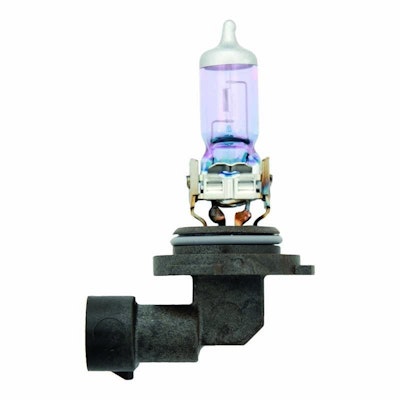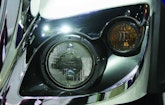
Interested in Trucks?
Get Trucks articles, news and videos right in your inbox! Sign up now.
Trucks + Get AlertsLoaded down with supplies and headed out for an early morning job, you notice movement alongside the road — is it a deer? It’s still dark and you can’t clearly make out the object. Any collision could mean thousands of dollars in damage — or much worse. Safety is paramount, and downtime is lost time. Who can afford to have their work truck parked for repairs?
Fortunately, you pass by safely, but when’s the last time you checked or changed your headlights? If you can’t remember, you could be putting yourself and the lives of others in danger.
Original equipment automotive headlight bulbs typically have about a five-year, 1,000-hour life span, but can lose up to 20 percent of their output in two to three years.
To make sure you can see and be seen, it’s best to inspect your headlights each time you drive. An easy way is to park your vehicle or truck on a level surface about 5 feet from a garage door or wall and turn the lights on. Both should be bright white. If one seems yellow or dim, it’s time for a replacement. You might also want to do a headlight restoration if the lenses have yellowed. While you’re at it, make sure your headlights are aimed properly. The beams should be at the same height on the wall.
A typical driver uses their low beams about 100 hours a year; high beams about 10 hours a year — commercial drivers much more.
Ronnie Tamez, owner of First Call Septic Services in Battle Ground, Washington, says he inspects his headlights every time he starts his truck.
“Our lights are on whenever we put the truck in gear,” he says. “We replace the headlights about every six months and keep two spares in the truck at all times.” Tamez spends about 10 hours a day driving and follows the recommendations of Mack/Volvo for bulb replacement.
HALOGEN OR INCANDESCENT
Most headlight bulbs today are filled with halogen gas. Introduced in the 1970s, halogen lamps burn brighter, are more efficient and last longer than incandescent bulbs.
“The benefits there, in what’s called the halogen cycle of lighting, is it allows the filament to burn hotter and perform better at the same wattage,” says Brian Noble, marketing manager, automotive light, for Sylvania. “The halogen gas, in its scientific form, is grabbing the tungsten that is burning off the filament and putting it back on the filament — not always in the same spot, but it’s putting it back on. If you’ve seen a burned out incandescent light bulb, there’s black on the sidewall of the glass. That’s the tungsten burning off. You won’t see that with a halogen light bulb.”
NEW TECHNOLOGIES
In the 1990s, high-intensity discharge (HID), or metal-halide technology, came into use. Brighter, metal-halide bulbs were slow to cool down and turn back on, as anyone who has been in a school gymnasium equipped with mercury vapor lights might recall. Adapting the technology to automotive use meant turning the process upside down.
“You had to have 80 percent output instantly and full power within four seconds,” Noble says. “The performance benefit of an HID system is it produces between two to three times more light than a halogen product with considerably less wattage: a low-beam halogen headlight is about 55 watts; an HID system is about 35.”
Keep in mind, because of their increased output, HID (xenon) headlights can blind oncoming drivers and are illegal for highway use unless factory installed. (Complete replacement kits to run legally with HID are available.)
Today, more and more vehicles use light-emitting diode (LED) technology. It can be found in dashboards and interior lighting, accent running lights, fog lights, brake lights, tail lights, backup lights — and some truck headlights. Brighter, focused, instantaneous light makes them a step up from other technology.
“The benefit of an LED brake light is full power instantly,” Noble says. “That can be 10-20 feet, compared to an incandescent light. The person behind you is going to see it that much sooner. And as we say, every foot counts.”
Although LED bulbs feel cool to the touch, they really aren’t.
“They create heat out the back,” Noble says. “A halogen or incandescent bulb creates more heat off the front.”
In addition to brighter, instantaneous light, the greatest advantage LEDs offer is longevity.
“People make claims of 50,000 hours,” Noble says. “In an automobile, that’s insane because low beams get about 100 hours of usage a year — 50,000 is forever in a car.”
THE LIFETIME BULB
In theory, you would never have to replace an LED. For that reason, Sylvania puts a lifetime warranty on its LED bulbs. Unfortunately, the supporting electronics are not as reliable, especially in the harsh truck world where water remains an issue. Next up in the ever-evolving world of vehicle technology is laser LED and organic or OLED lights. It could be years before they enter the replaceable bulb market.
Sylvania offers three levels of lighting beyond its basic OEM halogen bulb: UltraVision for better down-road vision; SilverStar for brighter down-road vision and greater clarity; and SilverStar Ultra for brightest down-road vision, whiter light, greater clarity and ultra night vision.
As part of its Headlights for Haulers NASCAR sponsorship, Sylvania has been putting SilverStar Ultra lights on trucks for years.
“They have a shorter life,” Noble says. “We know it. The hauler drivers know it. But in the end, it’s more important that when they’re driving 80,000 pounds and have millions of dollars behind them that they can see an item or object in front of them.”
VISIBILITY VS. LIFE SPAN
In each case, greater visibility means shorter life and higher cost. Replacing a 1,000-hour OE halogen bulb with a 250-hour aftermarket bulb will greatly increase performance but decrease the life span by about 75 percent. Note: Since each bulb is different, read the contents label for lumens and estimated life.
“We can make a light bulb that lasts a crazy amount of time,” Noble says. “But your performance is going to be less than optimal. Do you want to see that deer? Do you want to see that person walking? Do you want to see that branch in the road? Hitting it is a bad thing. That’s our mindset, and we’re very passionate about it.”
REPLACE IN PAIRS
For best visibility, it’s best to replace both headlights at the same time. If one bulb is burned out or showing its age, there’s a good chance the other will soon do the same.
When changing bulbs, be careful not to touch the glass. Wear clean latex or nitrile gloves to prevent skin oils from getting on the bulb. Trace amounts of oil or grease on the glass can create hot spots that will cause the bulb to crack.
“The oils on your finger act like dirt,” Noble says. “It doesn’t let the light pass through. And if the light can’t pass through, it bounces around the glass, increases the heat within and helps burn out the filament.”
Noble says if you get oil on the bulb, wipe it off with rubbing alcohol. Finally, double-check the bulb to make sure it’s sealed properly — a hot bulb touching the lens will melt the plastic.
You can tell if the bulb is sealed properly by focusing the light on a wall – the beam should be level, not pointing up or down.
Like any maintenance, it’s best to check the owner’s manual before you begin — even for something as elementary as changing a light bulb.







